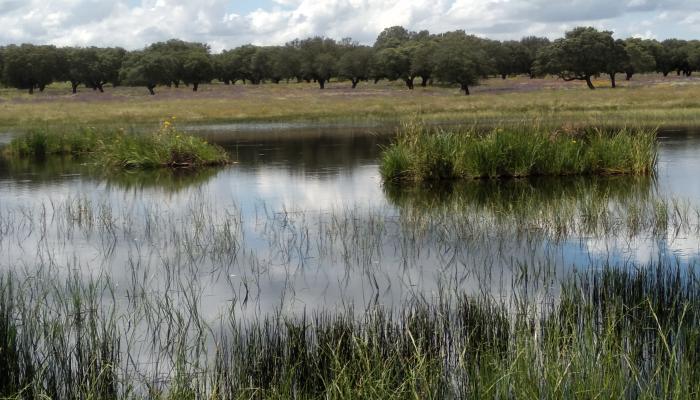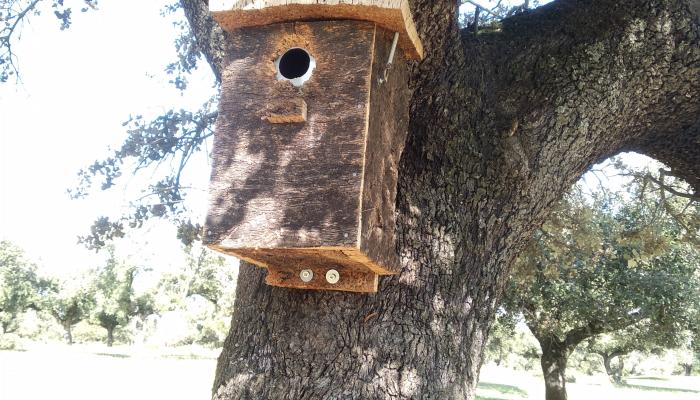
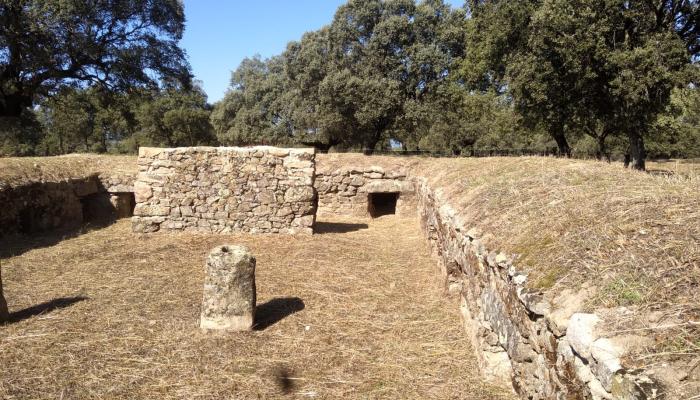
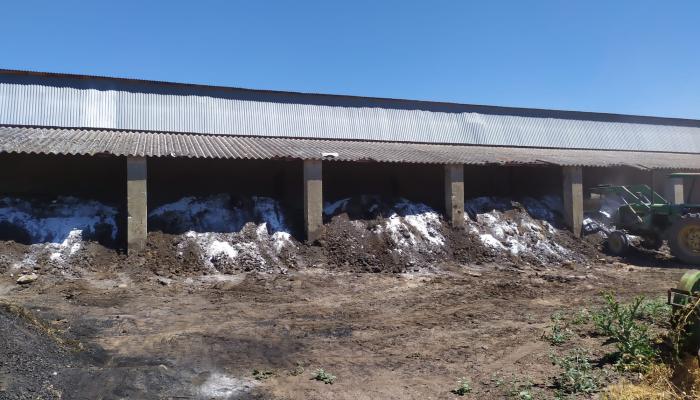

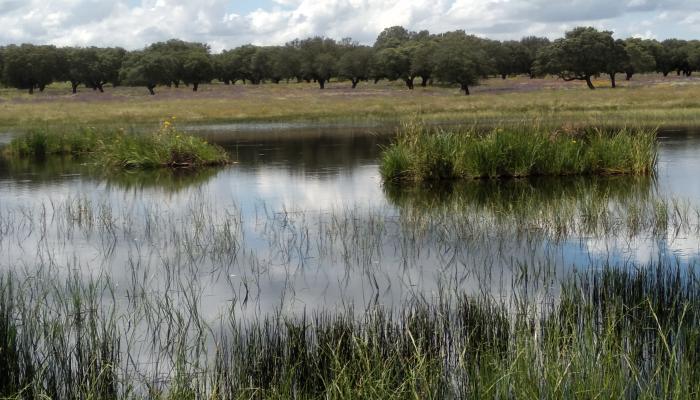
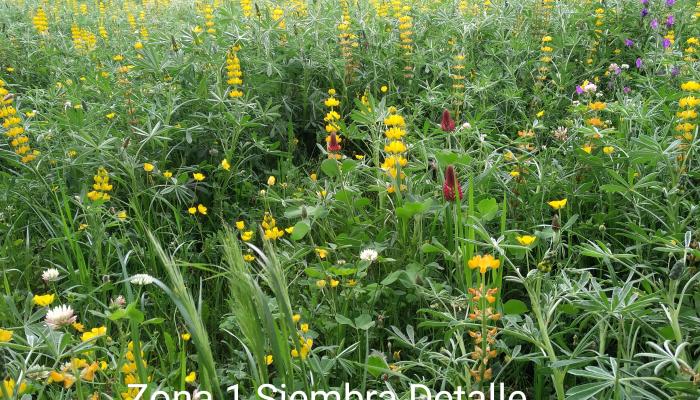
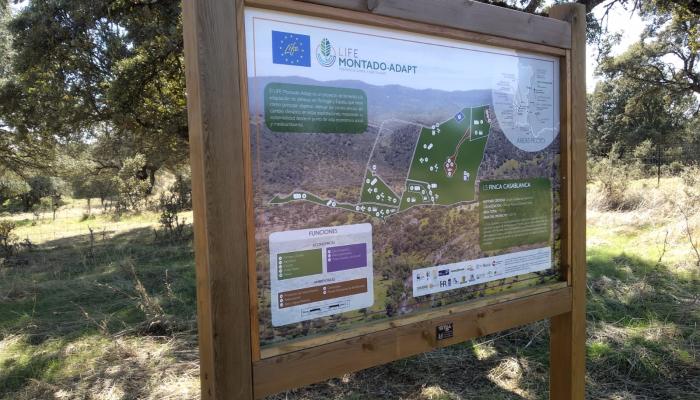
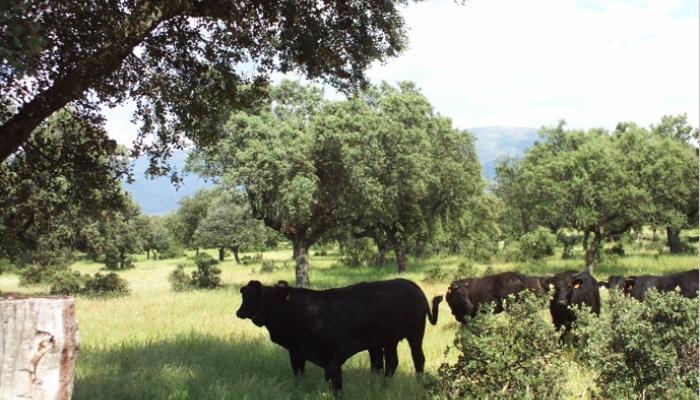
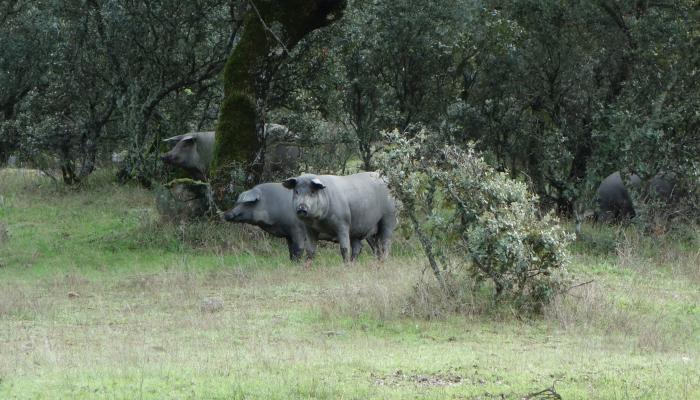
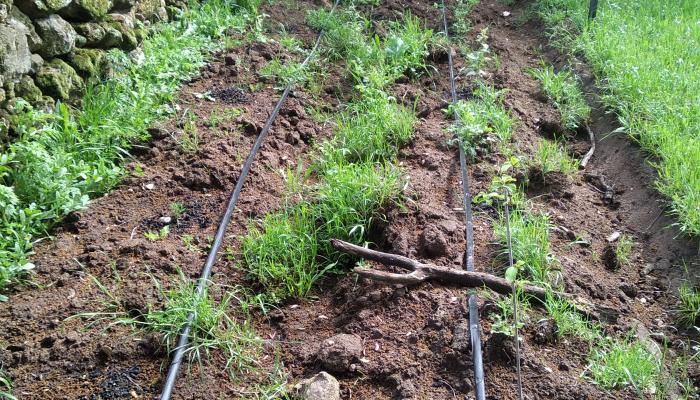
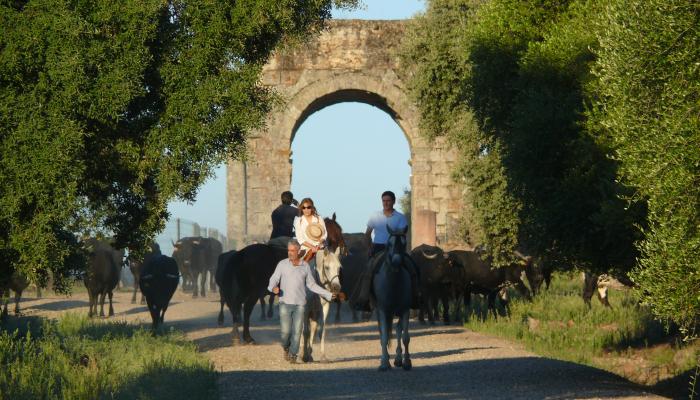

Montado-Adapt is a project aimed at promoting the adaptation of dehesas, or montados—extensive, semi-natural systems of scattered woodland formations dominated by Quercus species and maintained through human activity. These systems integrate agricultural, livestock, and forestry practices, and they shape the landscapes of the southern Iberian Peninsula.
The main objective of the project is to mitigate the impacts of climate change by promoting adaptation within these ecosystems and enhancing their economic, social, and environmental sustainability.
Adaptation through Integrated and Diversified Management Systems (IDMS) focuses on crop diversification, taking into account not only soil and other endogenous factors but also climatic conditions. This approach increases productive capacity, stabilizes sustainability outcomes from year to year, and helps reduce both environmental and demographic desertification.
The project supports landowners and managers who are interested in adopting IDMS strategies on their properties..
The The climate scenarios projected for the Iberian Peninsula in the coming years indicate a rise in average temperatures, more frequent droughts, and a decline in both the amount and frequency of precipitation and frost events.
These projections are particularly alarming for montado/dehesa systems, which are already exhibiting signs of degradation, highlighting the urgent need to understand and anticipate these impacts and to develop adaptation strategies that ensure the long-term viability of these ecosystems and the livelihoods they support. Continued reliance on traditional management systems is no longer a viable path toward sustainability.
In response to these challenges, Life Montado-Adapt prioritizes the progressive adaptation of these systems to current and future climate conditions and their associated impacts in the Alentejo region (Portugal), Extremadura, and Andalusia (Spain). The project has resulted in the development of an Integrated Dehesa Management System (IDMS), tailored to the specific conditions of each of the 12 selected pilot areas, implementing a comprehensive set of adaptation strategies grounded in the three pillars of sustainability: environmental, social, and economic.
The case presented here refers to the IDMS developed and implemented at the Finca Casablanca, located in the municipality of Oliva de Plasencia (Cáceres), corresponding to pilot area L5 of the project.
Finca Casamblanca has a total area of 415 hectares, distributed as follows:
- Mown meadows……………………...............75 ha
- Cork oak forest in production………………66 ha
- Wooded pasture (ash and oak)……………15 ha
- Certified organic olive grove….…..……...6.5 ha
- Holm oak dehesa……………………………….259 ha (30-40 trees/ha)
Since 1860, the property has been a privately owned dehesa, traditionally managed with rational and environmentally sustainable practices devoted to agricultural and livestock activities. Summer transhumance was practiced toward the Béjar and Candelario mountains, where the livestock would remain until November or December, depending on the autumn rains.
In the 1970s, these practices were abandoned. Grazing pressure increased, and transhumance ceased, marking the beginning of the estate’s degradation.
Currently, Finca Casablanca maintains a generally healthy and appropriately dense tree population, including pruned trees. However, maintaining these conditions requires improved natural regeneration, as some areas lack young trees, and where they exist, they are grazed down, indicating high grazing pressure.
The estate is located just 6 km from the A-66 highway, offering good connectivity to major transportation routes.
Its tree cover is dominated by holm oak (Quercus ilex subsp. ballota L.) and cork oak (Quercus suber L.), both of which are at risk of disappearing according to future climate projections.
The herbaceous layer in the study area is relatively diverse, although poor in leguminous plants. Nonetheless, it exhibits high biomass and carbon sequestration (44.22 t/ha and 21.05 t/ha, respectively), as a result of the good density and health of the trees.
The main soils on the estate are dystric Regosols derived from granite—poorly developed, shallow, coarsely textured, and with an acidic surface horizon. In low-lying areas, there are finer-textured soils subject to temporary waterlogging.
The site exhibits good invertebrate diversity, with a clear dominance of beetles (Coleoptera), followed by wasps and bees (Hymenoptera) and spiders (Arachnida).
In terms of birds, Finca Casablanca is one of the areas with the highest number of observed species, though specialist forest species are limited. Therefore, recovery through natural shrub regeneration is important.
Regarding fungi, up to 12 species have been identified on the estate, of which only one is edible (Macrolepiota procera) and of low commercial value. There is a higher abundance of saprophytic than mycorrhizal species, indicating poor conditions in this regard. Hence, the presence of ectomycorrhizal species should be increased through actions such as installing livestock exclusion fences, promoting natural regeneration, and improving permanent soil cover.
Given these circumstances and considerations, the estate faces the following main challenges:
- Maintaining the productivity and profitability of livestock farming.
- Maintaining the quality, yield, and biodiversity of forage.
- Promoting the regeneration of productive tree cover.
- Controlling the presence of pests (defoliating caterpillars and wood-boring insects).
- Preventing further decline of the tree population.
- Preserving water and soil resources.
Enhancing, conserving, and increasing biodiversity.
The IDMS is a gradual and integrated approach, designed at the farm level, to enhance, in a balanced way, the economic, social, and environmental adaptation of the montado/dehesa to expected climate changes.
Its design for each of the 12 pilot areas involved was carried out during 2017 and 2018, with implementation beginning in autumn 2018.
The steps taken to achieve the final design of the IDMS for each pilot area were as follows:
- Identify the specific characteristics and limitations of the estate and its management.
- Provide training to farmers and partners on topics relevant to the definition and implementation of the IDMS.
- Evaluate the current state of the montado/dehesa estate by analyzing climate models, aerial imagery, mortality and biodiversity studies, the presence of Phytophthora cinnamomi, etc.
- Define the goals and objectives of the estate to guide the adaptation pathway to follow.
- Define the adaptation strategies to be implemented (economic – products/services –, environmental, and social), as well as their locations.
- Define the species to be used, taking into account their market potential and suitability for expected climate scenarios.
- Identify the adaptation measures that will be used in the application of the strategies on the ground.
- Plan the implementation: define the planting model, materials to be acquired, budget, procure materials and services, and prepare the land.
The IDMSs designed for each estate comprise 5 fundamental objectives:
- Diversify plant production by alternating agricultural crops with forestry species.
- Opt for economically viable crops and varieties that are more resistant to adverse conditions resulting from climate change.
- Act in accordance with international standards, aiming for the certification of the products obtained.
- Improve soil fertility through different techniques such as green manures, mycorrhization, crop enhancement, among other actions.
- Diversify estate outputs through the production and processing of bioproducts and eco-services.
In the case of Finca Casablanca, the Board of Directors of the Casablanca-Cáparra Group, owner of the property, through appropriate agrosilvopastoral management, aspires to:
- Achieve a profitable dehesa through the diversification of productive activities and income sources, primarily agriculture, livestock farming, and tourism.
Improve the environmental values and services that the dehesa provides to society, specifically biodiversity, carbon sequestration, soil fertility, and landscape quality.
The Finca Casablanca is located in a region with significant natural, botanical, faunal, and landscape values, as well as cultural heritage (the archaeological site of Caparra was, until its expropriation, part of the estate itself).
It is not uncommon to observe strictly protected wildlife species such as the black stork, common crane, or various birds of prey, although the estate itself is not under any official protection status.
The estate is certified for organic farming, which helps to ensure the conservation of the natural values it holds.
Among the actions undertaken on the estate, the following stand out as fundamental:
- Regeneration and diversification of productive tree cover
- Promotion and protection of natural regeneration, through pit digging and tree wells, protective elements, compost or biochar, and supplementary irrigation.
- Planting of high-quality plant material, based on local plants or seeds:
- planting of 8 ha of riparian and wetland tree cover (ash, Fraxinus angustifolia, and hackberry, Celtis australis)
- planting of 6.7 ha of strawberry trees (Arbutus unedo), cork oaks (Quercus suber), hawthorns (Crataegus monogyna), turpentine trees (Pistacia terebinthus), wild pear trees (Pyrus bourgaeana), …
- Increase the quantity and quality of livestock feed:
- Efficient management of grazing resources by increasing pasture area and yield, with land preparation and sowing of mixed seeds of clovers, yellow lupin, and various forage grasses and legumes (Trifolium sp., Lupinus luteus, Medicago polymorpha, Lolium multiflorum, Ornithopus sativus, ...)
- Increase and improve surface water (1,1 ha)
- Water retention in the landscape to promote soil infiltration, with planting of willows (Salix sp.), ashes, hackberries, and some shrubs.
- Improvement of the water quality in ponds and lagoons through the installation of platforms or islets with plant species capable of filtering water, such as mint (Mentha sp.), irises (Iris sp., Lilium sp.), reeds (Phragmites sp.), …
- Increase and conserve natural biodiversity:
- Protection and promotion of wildlife through installation of nest boxes for insectivorous birds (approx. 40 boxes).
- Establishment of hedgerows and diverse plantings (0,6 ha):
- 300 meters of perimeter planting with melliferous species such as hawthorns, turpentine trees, and various aromatic plants (rosemary, lavender, thyme, …)
- 5.000 meters of various tree and shrub species of the following types:
- dry: cork oaks, wild pears, almond trees, buckthorn (Rhamnus alaternus), and broom.
- wet: hackberries, strawberry trees, hawthorns, junipers (Juniperus oxycedrus), turpentine trees, …
- 800 meters of carob trees (Ceratonia siliqua) planted at 5-meter intervals, interspersed with aromatic plants.
- Other services and products enabling diversification of products and livelihoods:
- Promotion of nature tourism (rural, hunting-related, birdwatching, wildlife photography, …)
- Increase in diversified food and crop production in agroforestry areas, including compost, mushrooms, seeds, aromatic and medicinal plants, beekeeping, firewood, nuts, …
The estate was certified under PEFC through a group certification that lowers unit costs, which will allow higher value for marketed products.
In terms of productive diversification, a new product was developed: BIO Caparra compost, which has been marketed in the Jerte Valley, particularly to organic cherry producers. The estate also established a company for the commercialization of a surface water purification product, a nature-based solution called natural cork islands.
Climate projections for the coming years predict an increasing aridification of the southwest of the Iberian Peninsula. In the areas currently occupied by dehesas, summers will become drier and hotter, summer droughts will last longer, and the probability of heatwaves, intense rainfall events, and prolonged dry periods will increase. Furthermore, climate change could also affect animal health, leading to an increase in climate-related mortality and disease.
Considering that the dehesa is an extensive agrosilvopastoral system, its greatest vulnerability to climate change lies in its high dependence on rainfall, both for direct livestock consumption and for pasture production. The projected reduction in precipitation (by up to 100 mm/year) and increase in temperatures (by up to 4 °C) will therefore lead to a decrease in the capacity to produce pasture, acorns, and other dehesa resources.
In this context, improving the system’s adaptive capacity to climate change begins with the efficient use of dehesa resources, which would help ensure its sustainability and resilience to extreme climate events (high temperatures > 39 °C, heatwaves, reduced winter frosts, etc.).
For this reason, the implementation of various adaptation—and even mitigation—measures, such as those proposed in these IDMSs, inevitably contributes to better conservation of the resources that dehesas can offer, optimizing livestock management and the production of ecosystem services, increasing the diversity of exploitable resources, and improving their use.
All these measures (soil preparation and improvement, planting and regeneration of vegetation cover, expansion and increased resilience of pasture areas, improved water infiltration and quality in ponds and/or storage lagoons, promotion of biodiversity, and exploitation of new ecosystem services) will allow dehesas or montados to be better prepared to withstand and adapt to the impacts of climate change.
The project, coordinated by the Associação de Defesa do Património de Mértola (ADPM), involves a multidisciplinary team composed of various public and private technical-scientific entities, both for-profit and non-profit, as well as owners and managers of dehesas in Spain and Portugal:
Participants:
- Coordination: ADPM – Associação de Defesa do Património de Mértola (Portugal)
- Technical partners:
- FSG – Forestry Service Group (Netherlands)
- UNEX – University of Extremadura
- UNAC – União da Floresta Mediterrânica (Portugal)
- TERRADRONE (Portugal)
- Pilot estates:
- Mata Nacional do Cabeção – ICNF – Instituto da Conservação da Natureza e das Florestas (Portugal)
- Dehesa Boyal de la Piedra – Municipality of Villasbuenas de Gata
- Herdade do Freixo do Meio – Sociedade Agrícola do Freixo do Meio Lda. (Portugal)
- Casablanca Estate – Grupo Casablanca-Cáparra SL
- Mata Nacional de Valverde – ICNF (Portugal)
- Dehesa del Guijo – Dehesa del Guijo SA
- Herdade do Azinhal – ANSUB – Associação de Produtores Florestais do Vale do Sado (Portugal)
- Finca La Rinconada – Explotaciones Agropecuarias La Rinconada SA
- Herdade da Ribeira Abaixo – Ministério da Agricultura and FCUL – Faculdade de Ciências da Universidade de Lisboa
- La Atalaya – CAGPDS – Regional Ministry of Agriculture, Livestock, Fisheries and Development of the Andalusian Government
- Área Florestal de Sines – ICNF (Portugal)
- Herdade da Coitadinha – EDIA – Empresa de Desenvolvimento e Infraestruturas do Alqueva SA (Portugal)
- Scientific partners:
- INIAV – I.P. Nacional de Investigação Agrária e Veterinária (Portugal)
- FCUL – Faculdade de Ciências da Universidade de Lisboa (Portugal)
- UEVORA – University of Évora (Portugal)
As previously mentioned, the action described refers to the IDMS implemented at Casablanca Estate, located in the municipality of Oliva de Plasencia (Cáceres), designated as pilot area L5 of the project.
The development and implementation process of the LIFE Montado-Adapt project consists of 11 stages, which collectively enable the successful implementation of the Integrated Dehesa Management Systems (IDMS) in each of the project’s pilot areas:
- Evaluation of the pilot areas
- Definition of indicators and baseline conditions
- Development of the Integrated Dehesa Management Systems (IDMS)
- Training of landowners and project partners
- Implementation of the IDMS
- Cooperation with market stakeholders.
- Replication in other interested estates
- Implementation of certifications in the pilot areas
- Marketing of products derived from the IDMS
- Evaluation of results
- Policy recommendations and dissemination
The project is being carried out in 12 pilot areas, one of which is the Finca Casablanca, owned by Grupo Casablanca-Cáparra SL. The results of Montado-Adapt will be disseminated at the conclusion of the project as examples of climate adaptation models.
These results will stem from the implementation of adaptation technologies across a total of 1,250 ha of dehesa/montado, with interventions tailored to the specific conditions of each estate, as in the case of Casablanca.
The first group of expected results relates to:
- Achieving the implementation of the IDMS in each pilot area, specifically tailored to the characteristics and circumstances of each.
- Ensuring and improving biodiversity functions, including a 10% increase in bird and butterfly species presence.
- Restoring the diversity and structural complexity of the characteristic vegetation of these habitats, which are frequented by the Iberian lynx.
- Improving the socio-economic benefits of the estates, including at least eight viable income sources for both the national and international markets, and an increase in income of €150/ha.
Improving performance to 1 FTE*/10 ha, increasing the Internal Rate of Return (IRR) by at least 6 percentage points.
(*) FTE: Full-Time Equivalent
- Contributing to climate change mitigation, with carbon sequestration of approx. 1 t CO₂eq/ha.
The second group of expected results refers to the replication and scaling up to expand the number of estates adopting these adaptation technologies, resulting in:
- The transfer of experiences and knowledge to other interested landowners (11 project partners transferring to another 11 landowners), achieving a total critical mass of 110 landowners and approximately 10,000 ha under IDMS adapted to each property.
- The implementation of a marketing campaign to promote Dehesa-derivers products.
- The preparation of a Group Certification process.
- The creation of synergies with public and private entities to promote policies and legislation beneficial to the development of the dehesa / montado system.
- The creation of information and dissemination networks, with at least 10 exchange events with policymakers and 10 meetings with similar projects.
Other activities (project website, contact and research database, scientific articles, social media, visits, brochures, …).
Currently, Finca Casablanca carries out an integrated silvopastoral management approach, aiming to maintain the ecological balance of the dehesa. The property promotes and practices organic agriculture and livestock farming, which involves an orderly management of resources, avoiding problems associated with overgrazing, such as the elimination of regrowth of Quercus species, hawthorns, and wild pear trees (Pyrus bourgaeana), as well as the removal of the shrub layer, among other issues.
The estate has exceptional regeneration in some of its plots and is one of the few dehesas where Quercus species are still found in association with hawthorns and wild pear trees. Thanks to the excellent condition of the dehesa, notable bird species can be found within it.
Regarding livestock activity, the estate practices transtermitance between Oliva de Plasencia and Hervás, moving about 30 head of cattle during the summer period and until December. During the rest of the year, it implements a holistic grazing plan, designed with support from the Transhumance and Nature Foundation, aiming to conduct grazing that is compatible with rational use of dehesa resources, keeping livestock in plots and rotating them in an orderly manner to avoid overexploitation of resources.
In line with the Forest Fire Prevention Plan, Quercus trees are pruned, and cork is harvested. The entire estate includes a firebreak area along its perimeter and features numerous roads and water points.
Finally, Casablanca carries out rural tourism activities, with a dedicated rural house and ecotourism routes through the dehesa, including visits to the archaeological site of the Roman city of Cáparra, adjacent to the estate. The Vía de la Plata (Camino de Santiago), which coincides with the Soriano-Occidental drove road, runs through the property. These activities fall under its Tourism Activity Management Plan, regulated by the General Directorate of Tourism of Extremadura..
Among the resources produced, the following stand out:
- Forestry:
- Cork (900 quintals in the last harvest)
- Firewood (around 25,000 kg/year)
- Montanera (acorns from holm and cork oaks), used to fatten 125 pigs
- Honey, with 150 beehives placed from October to June
- Agricultural:
- Meadows for hay production to feed livestock during unfavorable periods (75 ha)
- Organic olive grove for oil production (6.5 ha)
- Livestock:
- Cattle (135 native suckler cows of the Avileña and Berrenda en Negro breeds)
- Organic pigs (14 certified Iberian pigs)
- Acorn-fed pig fattening during the montanera (125 pigs))
The estate also holds a water use concession from the Ambroz River of 0.25 l/sec and has 2 large artificial ponds, 6 pools, and 1 natural spring. In addition, a seasonal stream called Charcos Blancos runs through the estate. All water resources are used for livestock and agroforestry purposes.
As for other infrastructures, the estate includes restored old pigsties and 1 shepherd’s hut, all refurbished through this LIFE Project.
The total cost of the project amounts to €3,439,746, of which €2,051,538 are financed by the European Union through its LIFE programme LIFE15 CCA/PT/000043.
The budget allocated for the actions implemented in pilot area L5 at the Casablanca estate amounts to a final total of €115,316.
In relation to the project, there are three main lines of action against climate change that have been proposed and/or undertaken at Finca Casablanca:
- Increasing climate resilience through assisted migration, the use of climate-adapted genotypes, and adaptive management
- Diversifying stands by planting other native species
- Converting stands through the planting of non-native species
These approaches are subject to various regulations, both general and specific, as outlined below:
- National/regional regulations:
- Law 10/2006 of April 28, which amends Law 43/2003 of November 21, on Forests
- Law 42/2007 of December 13, on Natural Heritage and Biodiversity, which designates 6,310 evergreen oak dehesas (Quercus spp.) as natural habitats of community interest
- Decree 111/2015 of May 19, which amends Decree 13/2013 of February 26, regulating the administrative procedure for certain forest uses and other activities in the Autonomous Community of Extremadura
These laws prohibit the introduction of non-native species, even if they are adapted to future climate conditions (approach 3) and restrict densification or reforestation to native forest species only (approach 2). As a result, diversification using native species such as strawberry tree (Arbutus unedo), pistachio, almond, wild olive, olive, and other potentially valuable species like Cytisus proliferus and Medicago arborea is not permitted.
- Specific regulation:
- The authority responsible for organic control and certification in Extremadura is the General Directorate of Agriculture and Livestock, under the Regional Ministry for the Environment and Rural Affairs, Agrarian Policies and Territory of the Government of Extremadura, which, within its competencies, prohibits the planting or sowing of species not certified as organic, even when they are not available on the market and even if management complies with organic standards.
This has led to the removal of certified areas on the estate and, consequently, a reduction in the products marketed under this production method.
For the development of this LIFE Montado-Adapt project, the estimated implementation period is 5 years, with activities having started on September 1, 2016, and scheduled to conclude on September 1, 2021.
- Carvalho S. 2017. Finca Casablanca. Ficha informativa L-5. CCIAM/cE3c. Faculdade de Ciências. Universidade de Lisboa, Portugal. 3 pp.
- Universidad de Extremadura (UEX); Finca Casablanca. 2019. Sistema Integrado de Gestión de Dehesa.- Area piloto L5 - Finca Casablanca. Acción C2 – Diseño de los Sistemas Integrados de Gestión de Dehesa. 13 pp.
María Bastidas
Project Coordination
ADPM – Associaçao de Defesa do Património de Mértola
Largo Vasco da Gama S/N
7750-328 Mértola (Portugal)
Email: ambiente@adpm.pt
Phone number: +351 286 610 000



